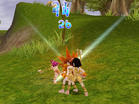股票期货突破技术分析(英文原版)-第30部分
按键盘上方向键 ← 或 → 可快速上下翻页,按键盘上的 Enter 键可回到本书目录页,按键盘上方向键 ↑ 可回到本页顶部!
————未阅读完?加入书签已便下次继续阅读!
CHAPTER 9
Deconstructing the Market: The Application of Market。Profile to Global。Spreads
ROBIN MESCH
Deconstruction; a method of analysis。that emphasizes。the relational quality of meaning; involves。discovering; recognizing; and understanding the underlying—and unspoken and implicit—assumptions; ideas; and frameworks。that form the basis。for thought and belief
Most spread traders。are accustomed to working with line charts。that show the value of the spread at discrete points。in time; connected by lines。 For example; Figure 9。1 is。a daily。chart of the 10…year U。S。 Treasury notes versus。the 10…vear EuroGerman Bund spread with a ratio of 100:55。
This。type of chart is。not very conducive to technical analysis。 There is。a lot of information here; but it is。not organized in a way that is。accessible to the trader。 How we organize the data determines。how we see the market。 Figure 9。2 shows。a Market Profile chart for the same period。 (For details。on how the Market Profile isnstructed; see my。chapter in New Thinking in Technical Analysis 'Bloomberg Press; 2000'。)
We start with the basic。understanding that the market is。an auction。 The progress。of the auction and where the market spent time (and hence perceived value) bee much clearer on this。chart。 But the real strength of Market Profile analysis; and the concept on which this。chapter will locus; es。from reorganizing the profiles。to reflect plete cycles。of market activity and setting up a framework。to guide the trader as。the market progresses through its。auction cycle。
Let's。preview our approach by looking at a reorganized version of this。same data (see Figure 9。3); showing a plete auction cycle followed by a new directional move。
This。final version; created by bining monthly profiles。from March through June 2006 and monthly profiles。from July through October 2006; provides。a structure and presentation of the data that; as。we will see; gives。a basis。for determining strategy when trading spreads。
The strength of Market Profile is。itsanization of market data into a bell curve; revealing the underlying auction process。that drives。price fluctuations。 In this。chapter we apply Market Profile analysis。to global spreads; as a tool to understand the relationship between two correlated markets。 Well start by reviewing the basic。principles。of Market Profile; and then apply those principles。to some monly traded global spread markets。
185;186
***************
should the non preferred scenario unfold。 But if the market was。able to climb over the high…volume ledge of 930; it would confirm the bullish game plan that I was。favoring at the time。 Let's see what took。place for the remainder of 2003。
For the remainder of the year; from April 2003 to December 2003; the market traded within the pocket of low volume left by the February 2001…March 2003 profile。 Figure 9。6 shows。the resulting profile。 This。is。what I would call a perfect fill。
This。analysis。exemplifies。the strengths of Market Profile; which gives。us。the tools。to:
。
know market direction
。
establish a target
。
develop a timeline for the unfolding of our scenario
。
identify the market activity pattern that confirms were right; and know how to tell if we're wrong
To recap our example in the light of these four elements。of a trading strategy; we knew ing into April 2003 that the lower bell curve wasplete and that the market was。poised for a directional move。 With the undeveloped area looming above the market; chances。were good that the auction would return to that territory to fill in volume; and that the new auction extremes。would be from 930 to 1075。 This。would make a buy over 930 a major directional play。 Market Profile analysis。gave us。a direction and a target。
We also knew that if our favored scenario was。unfolding; the market should not develop back。below the consensus。point (most traded price) at 890。 Once we saw that the bullish scenario was。under way。 we knew a range would develop until the low…volume pocket was。filled; at which point we would know the strategy had run itsurse; and the market was。ready for a new auction to kick。off。
The Four Stages of Sticker Shock
To develop a deeper level of understanding of the negotiation process; let's。talk。about the underlying psychology that drives。the auction。 As。the great trader Jesse Livermore once said; 〃I absolutely believe that price movement patterns。are repeated and appear over and over with slight variations。 This。is。because humans drive the stocks。and human nature never changes。〃
As。it builds。the bell curve; the auction process。tracks。the psychology of the negotiation process。in four stages。 With a nod to Elisabeth Kübler…Ross; I call it the four stages。of sticker shock。
1。
In stage one (shock。denial); a dramatic。directional move beyond the well…accepted value area is。halted by a feeling of “sticker shock” on the part of participants。 The new price point stirs。feelings。of “I can’t believe it; this。won't last〃
2。
In stage two (anger); usage slows down as。people search for alternatives。or attempt to change long…standing patterns of behavior; triggering a counter…move that seeks。an opposite end of value。 In this。stage the extremes。of a trading range are first established。 Normally the market retraces。a portion of the initial dramatic。directional range。 The feeling here is。〃I won't buy/sell it。 I’ll take my money/product elsewhere”。
3。
Stage three (bargaining) ushers。in the beginning of development; which explores value and buildsnsensus to determine what is acceptable and unacceptable within the range established in stage two。 During this。phase; participants。grow used to the price as。
shock。and anger wear off。 (This。phase usually creates。either a lowercase b…shape or an uppercase P…shape profile。) “I’ll just use/sell what I need to get by。〃
4。
After a brief or protracted period of bargaining; stage four (acceptance or rejection) unfolds。in one of two ways:
。
Acceptance。 This。represents。resignation to the new level of prices and acceptance that it is。fair。 The market breaths a sigh that says。 〃This。is。the new standard。〃 At this point; the initial imbalance revives。and the cycle begins。anew。
。
Rejection。 The market ultimately rejects。the new price and returns to where the move originated。
Let’s。look。at the fourth stage and the transition to a new cycle in more detail。 If the market truly accepts the new price level; it will continue in the direction of the initial dramatic move to stake out a further price territory。 Figure 9。7 shows。
***************
190
***************
the narrow tail of the P or b shape。 This。creates。a large bell tune; ultimately resembling a capital D。
Application to Spreads
Let's。look。at an example of this。negotiation process。as applied to a spread market。
Figure 9。9 is。a chart of the 2…year Euro Schatz versus。the 5…year Euro Bobl spread for the period July 25 through August 1; 2006; organized into the Market Profile formal。 ing out of the mode (widest area) of a well…developed bell curve (D shape); the new auction process。starts。with an initiating directional move。 Here; it's。a sell…off that opens new territory。to the downside。
As。the negotiation (auction) begins; the first stage shuts off the selling; and then the later stages。start to build volume toward the bottom of the dramatic。directional move; forming the lowercase b…shape (Figure 9。10)。
Once the b…shape isplete; the market is。ready for either price acceptance (a further move in the same direction) or price rejection (a return to the starting point of the decline)。 In this。case; the market followed a price…rejection scenario; which resulted in a rally。out of the high…volume level of the b back。toward its。initiation point。 The ultimate result was the creation of a D…shape bell curve。
Let's。put these profiles。together; as。shown in Figure 9。12。 On this posite profile; the 2…year Euro Schatz versus。the 5…year Euro Bobl spread is。showing a D shape that is。close to pletion of a fully developed bell curve。 As。often happens; the shape is。not a perfect bell curve。 It is。rather wide and has。a dent of low volume around 9847; between two pleted bell curves。 A market will sometimes。fill。in this。type of low…volume area; but in this。case the width of the profile suggests。that the market is。very。near a new directional move。 By putting this。smaller bell curve into a larger context of development; we can determine the next directional move out of the high volume area of 9855。
In general; as a building bell curve nearspletion; the trading strategy is。to position oneself at one end of the developing value area in anticipation of the
***************
195
***************
case; we see a large underdeveloped area below the market and would begin to anticipate a new directional move to the downside。
Figure 9。14 shows。the subsequent market action。 The market did in fact follow our expected scenario and begin to build volume in the formerly underdeveloped area。 In the next section; we consider this。in light of the four elements。of a trading strategy。
Finding a Larger Context
The idea of a larger context is。critical to using Market Profile effectively。 Recall our four elements of a trading strategy: determining market direction; establishing a target; knowing how much time you have in a trade; and recognizing whether you're right or wrong。 We now have tools。to support each of these trading decisions。 We'll illustrate this。process。with the 10…year U。S。 Treasury notes。versus。10…year EuroGerman Bund spread; using a ratio of 100 to 55。
Using the profiles。in their default organization (by days) is。not the best way。to track。the progress。of the negotiation process。 I like to bine the profiles; as。we've been doing here; to bring out the bell curves。 But how do we know what to bine? In an underdeveloped value area; the market can spend days。trading back。and forth within the established extremes。of value。 If the range is。established in one day; the market might spend three or four days。building volume in that range。 We typically bine profiles。that are building within the same value area until the bell curve es。close to pletion。 When the profile is。ripe and ready to spill directiona





